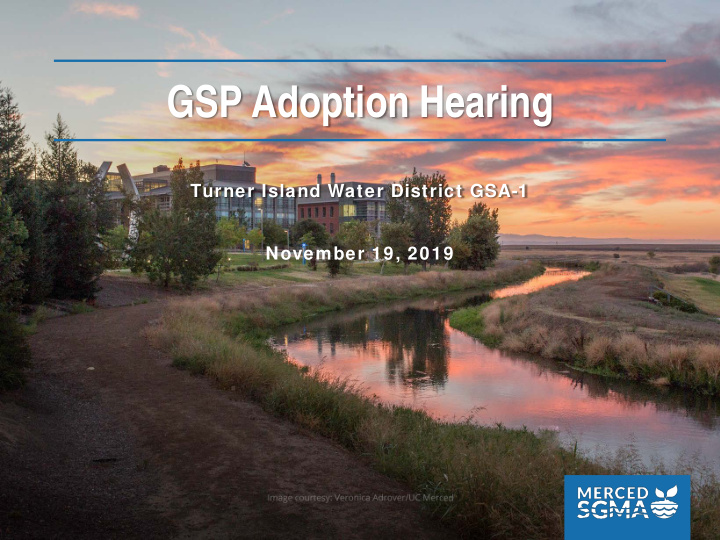



GSP Adoption Hearing Turner Island Water District GSA-1 November 19, 2019
SGMA Background
Sustainable Groundwater Management Act Overview Merced Groundwater Subbasin is in a state of critical overdraft SGMA requires a Groundwater Sustainability Plan (GSP) by Jan 1, 2020 for sustainable groundwater management of the basin within a 20-year timeframe
Three GSAs Prepared One Groundwater Sustainability Plan for the Merced Subbasin
The ultimate goal of the GSP is to put the basin on a path toward sustainable groundwater management – where pumping is balanced by recharge over the long term RECHARGE PUMPING
Key Elements of GSP Sustainability Goal Hydrogeologic Conceptual Model Water Budgets (Historical, Current, Projected, Sustainable) Sustainable Management Criteria based on consideration of sustainability indicators to avoid undesirable results Monitoring network and data management Projects and management actions to achieve sustainability by 2040 6
SGMA Requires Consideration of 6 Sustainability Indicators Chronic Lowering of Groundwater Levels Reduction in Groundwater Storage Seawater Intrusion Degraded Water Quality Land Subsidence Depletion of Interconnected Surface Water
Establishing Sustainable Management Criteria for the Basin For each indicator, the GSP must: 1. Define undesirable results for the basin (“significant and unreasonable” negative impacts) and determine if they could occur 2. Set sustainable management criteria that are intended to prevent undesirable results from occurring. Minimum Thresholds Measurable Objectives Interim Milestones 3. Establish a monitoring network
Development of Merced GSP
Public Engagement Occurred Throughout GSP Development Implemented Stakeholder Engagement Plan with Planning Roadmap 19 Coordinating Committee meetings (monthly since March 2018) 15 Stakeholder Committee Meetings (monthly since May 2018) 5 public workshops – Coordinated with SHE/LC, translation services available. Notices in English and Spanish, press releases and notices in Merced Sun-Star Bi-monthly coordination calls with Leadership Counsel and Self-Help Enterprises Mercedsgma.org provided meeting and GSP development information Periodic articles provided to Farm Bureau, EMRCD, and Merced Chamber 10
Regulations a Key Driver for GSP Timeline SGMA regulations require a GSP be adopted and submitted to DWR by January 31, 2020 to avoid state intervention This regulatory deadline drove GSP development process Plan is first effort to characterize groundwater management: Extent of overdraft Potential impacts Data gaps and information needs Groundwater allocation Projects to improve conditions Implementation plan will refine information and actions Plan adapts through updates every 5 years 11
GSP Underwent Public Review Published on Website July 19 Executive Summary, GSP (375pp), Appendices 30-day public comment period closed on August 19 Comments received in writing and at Sept 18 Joint GSA Boards Meeting After Sept 18 meeting and October 28 Coordinating Committee meeting, GSA board members and staff gave direction to consultant team in preparing response to comments and Final GSP 12
GSP Overview
Historical and Projected Water Budgets Summarize Basin Conditions Inputs and outputs – surface and groundwater supplies and demands Estimate the extent of Surface overdraft now and in the Water Deliveries future Surface Water Deliveries Subsurface Flows Historical conditions water budget shows an annual average rate of overdraft of 192,000 acre-feet per year (AFY) over Water Years 1996 through 2015.
GSP Establishes Sustainable Management Criteria for the Subbasin 16
GSP Estimates Sustainable Yield Net change in storage over long term = zero Sustainable yield estimate: 570,000 AFY Assumes projected conditions for land use and population growth with reductions in basin pumping to result in no net change in storage over the long term 18
An “Allocation Framework” is a way to Share the Basin’s Sustainable Yield Under SGMA, GSAs have authority to establish groundwater extraction allocations SGMA and GSPs adopted under SGMA cannot alter water rights
Water Allocation Framework is still being Developed Merced GSP contains an explanation that GSAs intend to allocate water to each GSA but have not yet reached agreement on allocations or how they will be implemented Merced GSP estimates of basin-wide sustainable yield and developed supply for illustrative purposes 20
Within each GSA, major groundwater users will have an allocation De Minimus Users Cities Agricultural Users (Well owners that pump 2 af/yr or Will be allocated a % Agricultural Districts less for domestic use) of their historical use Ag users will likely get a Cannot require metering. and will work with pumping allocation based on customers to reduce acreage (e.g. AF/irrigated acre) water use as needed
GSP Identifies Projects that will be Considered to Provide Additional Water Groundwater recharge Surface water projects: Projects to reduce projects: increase stored increase availability of demand: decrease water groundwater to allow surface water to meet use to reduce need for increased pumping for water demands (e.g., water beyond available participating agencies flood/stormwater groundwater and surface management) water (e.g., improved water use efficiency)
Next Steps in GSP Adoption Process
For Consideration Today Adopt final Merced Subbasin GSP Authorize submittal of GSP to DWR by January 31, 2020 24
Recommend
More recommend